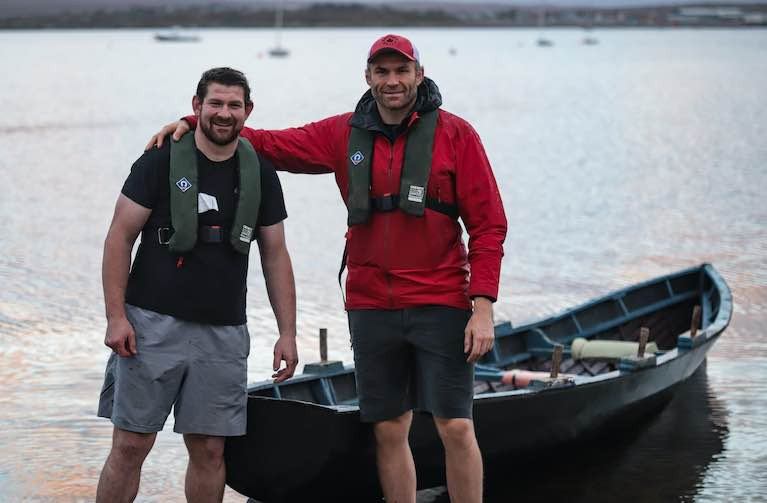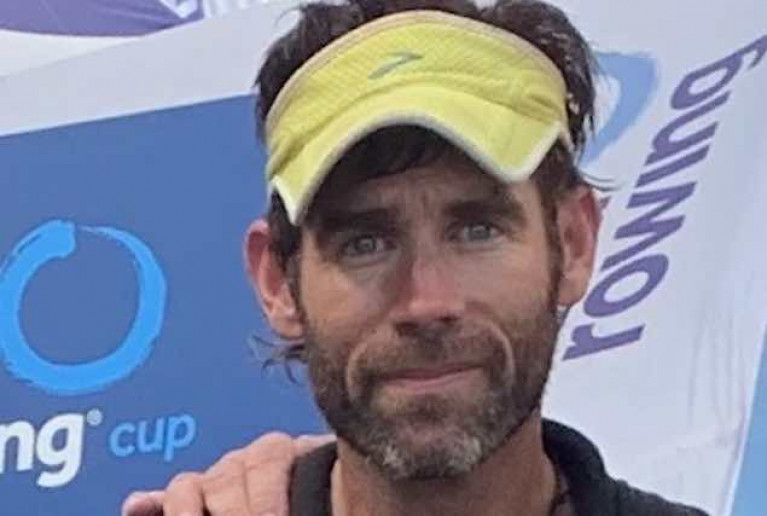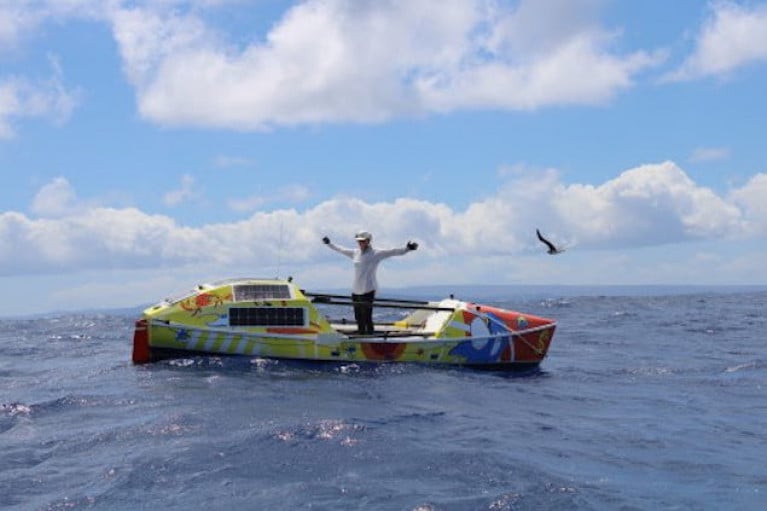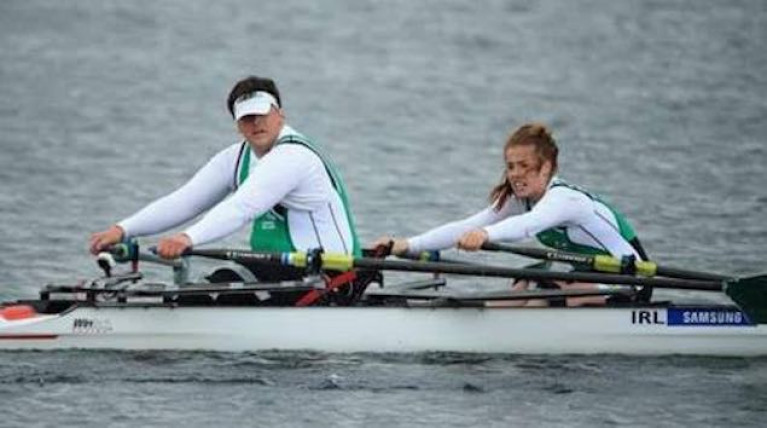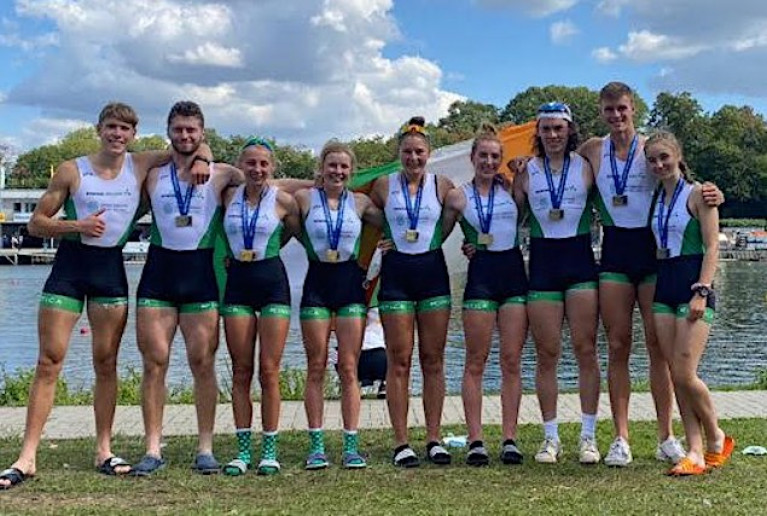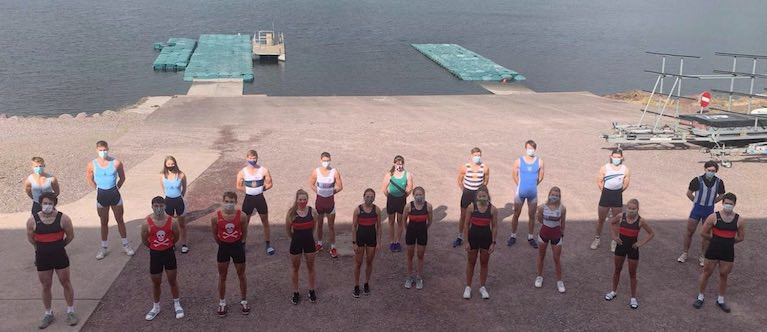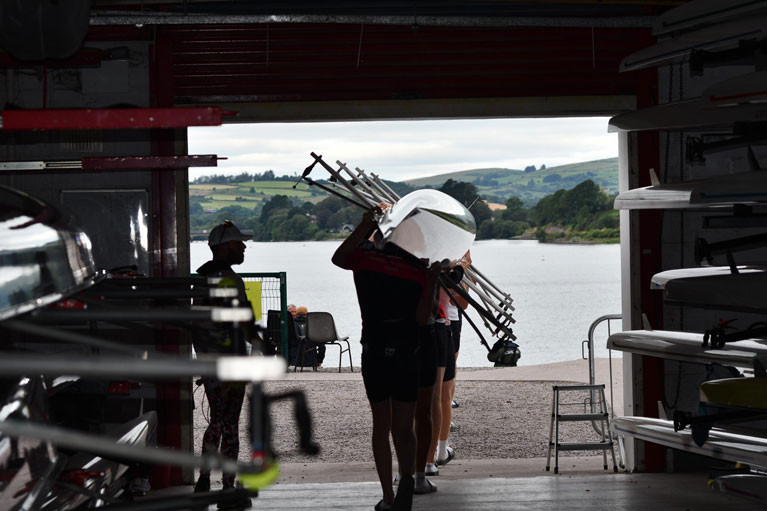Displaying items by tag: rowing
Sanita Puspure Advances to Women’s Single Scull A/B Semi-Finals at Euro Rowing Champs
Seven Irish crews were competing today at the 2020 European Rowing Championships. Four crews progressed to the A/B Semi-Final races on Saturday morning and three crews will race in the Repechage.
The W2-crew of Tara Hanlon and Emily Hegarty kicked off the Irish team’s racing this morning. The Irish pair were competing with crews from Russia, Italy, Greece and the Netherlands. The crew finished third with a time of 07:16.590. Tara and Emily will race in the Repechage.
Ronan Byrne and Daire Lynch competed in the Men’s double scull heat. The Irish crew competed against crews from Lithuania, Bulgaria, Slovakia, Finland and Serbia. Daire and Ronan finished second with a time of 06:22.020. Daire and Ronan have now progressed to the A/B Semi-Final on Saturday morning.
Lydia Heaphy raced in the Lightweight Women’s Single facing crews from Norway, Poland, Germany, Russia and Switzerland. Lydia finished sixth in her heat with a time of 08:01.550 and will race in the Repechage on Saturday morning.
Fintan McCarthy competed in the Lightweight Men’s Single, Fintan was competing with crews from Spain, Greece, Italy and Germany. Fintan finished third with a time of 07:05.980. Fintan moved into the Repechage later on Friday afternoon.
Fintan finished 1st in the Lightweight Men’s Repechage with a time of 07:07.35, Fintan will now compete in the A/B Semi-Final on Saturday.
The Women’s Four of Aifric Keogh, Eimear Lambe, Aileen Crowley and Fiona Murtagh competed in their heat alongside boats from Spain, France, Romania, Germany and Netherlands. The Irish Women’s Four finished second just behind the Netherlands crew with a time of 06:26.990. They will now race in the Repechage on Saturday morning.
Sanita Puspure raced in the Women’s Single Scull in Heat two. Sanita was competing against crews from the Netherlands, France, Serbia and Germany. Sanita finished second with a time of 07:35.510 and advanced to the A/B Semi-Finals on Saturday morning.
The Lightweight Women’s Double of Margaret Cremen and Aoife Casey finished 4th in their heat. They competed against crews from the Netherlands, Switzerland, Greece and Latvia and moved into the Repechage later on Friday afternoon.
Margaret and Aoife finished second in their Repechage with a time of 07:03.990. They will now compete in the A/B Semi-Final on Saturday.
Saturday European Rowing Races (IST) Irish interest
Women’s Pair (W2-) Tara Hanlon & Emily Hegarty – Repechage – 08:53
Men’s Double Scull (M2x) – Ronan Byrne & Daire Lynch – A/B Semi-Final – 09:13/09:18
Lightweight Women’s Single Scull (LW1x) – Lydia Heaphy – Repechage – 09:23
Lightweight Men’s Single Sculls (LM1x) – Fintan McCarthy – A/B Semi-Final – 09:33/09:38
Lightweight Women’s Double Sculls (LW2x) Margaret Cremen & Aoife Casey – A/B Semi-Final – 10:00/10:05
Women’s Four (W4-) Aifric Keogh, Eimear Lambe, Aileen Crowley and Fiona Murtagh – Repechage – 10:20
Women’s Single Scull (W1x) – Sanita Puspure – A/B Semi-Final – 10:45
Sanita Puspure To Defend European Rowing Crown in Poznan
This weekend senior Irish crews will be looking to continue the successes of the U23 and Junior crews who brought home six medals from their European Championships in September. Ireland will have seven crews competing at the European Rowing Championships in Poznan from the 9th -11th October.
Sanita Puspure will be defending her Championship after winning Gold at last year’s European Rowing Championships in Lucerne. In 2019, Sanita also won her second consecutive World Championship and qualified the Women’s Single Scull for the Olympics at the 2019 World Rowing Championships in Austria. After Sanita’s World and European Championships in 2019, she was named as the Irish Times/Sport Ireland Sportswoman of the Year.
Women’s Four
The crew of Fiona Murtagh, Aileen Crowley, Eimear Lambe and Aifric Keogh will be competing in the Women’s Four. Fiona has won the Head of Charles two years in a row and won at the Irish Rowing Championships. Aileen, alongside Monika Dukarska, qualified the Women’s Pair for the Olympics at the 2019 World Rowing Championships. Eimear has been competing internationally since 2015 and won Silver at the 2019 U23 World Rowing Championships. Aifric has been a member of the high-performance team for several years has won at the Irish Championships and set new World Records on the erg this year.
Fintan McCarthy will be competing in the Lightweight Men’s Single after a successful 2019. Fintan competed at the 2019 European Championships in Lucerne alongside his brother, Jake, in the Lightweight Men’s Double Sculls. Fintan then competed alongside Paul O’Donovan, winning Silver at the World Cup III in Rotterdam. Fintan and Paul went on to win Gold at the 2019 World Rowing Championship and qualify the Lightweight Men’s Double boat for the Olympics.
After a successful U23 European Championships, a number of our medal winners will be competing this weekend. Ronan Byrne and Daire Lynch look to continue their success after winning Gold in the Men’s Double at the U23 European Championships in September. In 2019, Ronan won Silver alongside Phil Doyle at the World Rowing Championships and the World Cup III; Ronan also won Gold in the Men’s Single at the 2019 U23 European Championships.
Margaret Cremen and Aoife Casey will be racing in the Lightweight Women’s Double in Poznan after winning the Silver Medal in the same category in Germany last month. Margaret and Aoife have competed together for several years and won Silver in this event at the Junior European Championships in 2017.
Lydia Heaphy will be competing in the Lightweight Women’s Scull, after winning Gold alongside Cliodhna Nolan in the Women’s Lightweight Pair last month. Lydia has experience competing in the Lightweight Single Scull having raced in the boat at the 2019 World Rowing Championships.
Tara Hanlon and Emily Hegarty won Bronze at last month’s U23 event, competing together in the Women’s Pair. Tara and Emily won Silver in the Women’s Four alongside Eimear Lambe and Claire Feerick at the 2019 U23 World Rowing Championships in Sarasota.
Irish Crews Competing
W1x
Sanita Puspure (OC)
M2x
Ronan Byrne (UCC)
Daire Lynch (Clonmel)
John Kearney (UCC)- Reserve
W4-
Fiona Murtagh (NUIG)
Aileen Crowley (OC)
Eimear Lambe (OC)
Aifric Keogh (UCC)
W2-
Tara Hanlon (UCC)
Emily Hegarty (UCC)
LM1x
Fintan McCarthy (Skibbereen)
LW2x
Margaret Cremen (UCC)
Aoife Casey (UCC)
LW1x
Lydia Heaphy (UCC)
New Support for Sport Initiative Launched By Texaco
Texaco has launched a support for sport initiative which sets aside a fund of €130,000 for distribution to sports clubs on a twenty-six, county-by-county basis, with successful applicants receiving €5,000 each.
At a time when many sports clubs may be experiencing financial strain, the initiative is one that Valero hopes will recognise the important contribution that sports clubs make to communities and throughout Irish society as a whole.
Open to sports clubs across the 26-counties of Ireland – irrespective of sporting discipline, size, membership, age, cultural appeal or gender – it is expected to attract all whose activities, goals and ambitions can, in the view of adjudicators, be materially advanced through the receipt and proper use of funding.
Speaking at the launch of the Texaco Support for Sport initiative, James Twohig, Director of Ireland Operations, Valero Energy (Ireland) Limited, described Irish sports clubs as a unifying element and a focal point for good in our communities. “In our cities, towns and villages, sports clubs are the magnets to which so many of us are drawn, homes-from-home where we meet and enjoy the friendship and camaraderie that sport offers and that all members and supporters share,” he said.
“By offering a new and innovative route to funding, we believe that the Texaco Support for Sport initiative will help uphold the unique values and characteristics that countless numbers of dedicated club members work so hard to preserve, whilst giving new expression to the cherished relationship that exists between the Texaco brand and generations of Irish sports enthusiasts,” James Twohig added.
Adjudication
Leading the adjudication process will be Texaco Support for Sport ambassador, acclaimed broadcaster and former Irish rugby international, Donncha O’Callaghan. “From my knowledge of sports clubs, gained at junior, senior and international level, I know how beneficial the Texaco Support for Sport initiative will be by bringing a much-needed benefit to clubs when it is least expected. Now more than ever, our clubs and volunteers need our support. I am really looking forward to reviewing the online applications, which provides clubs with the opportunity to showcase their importance to their local communities, and then seeing the recipients enjoy the benefit of this great initiative,” he added.
Application
Sports clubs can apply for funding from the Texaco Support for Sport from the 1 October 2020, the only requirement being that they be properly constituted and hold a valid Games & Sports Number (GS Number) issued by the Office of the Revenue Commissioners.
Those wishing to apply are invited to submit full details of their sporting activity, the purpose for which the funding is sought and the use to which it will be put. Full details of the scheme and its operation - together with registration, application, validation, adjudication and terms and conditions - are available to view at www.TexacoSupportforSport.com
Closing date for applications is the 31 December 2020 with adjudication taking place in January 2021.
Currach Crossing by Two Galway Rugby Players Planning Transatlantic Row
Two extraordinary men are set to row a currach from the Aran island of Inis Oírr to Galway city this morning to highlight their bid to cross the Atlantic in 2022.
Extreme adventurer and former professional rugby player Damian Browne and his lifelong friend Fergus Farrell aim to set a new Guinness world record in an unsupported row some 4,937km across the Atlantic in two years’ time.
Weather permitting, their 40 km (25-mile) row today (Tues 27th) launches the project’s crowdfunding campaign and symbolises the last leg of their Atlantic traverse.
The two men from Renmore, Galway city, and Athenry, Co Galway respectively have been friends and rugby players with Connacht and Galwegians Rugby Football Club since they were young.
Two years ago, Farrell became paralysed after a workplace accident and was diagnosed with a serious spinal cord injury.
After treatment in the National Rehabilitation Hospital (NRH) in Dun Laoghaire, Co Dublin, he walked 206 km from the place of his accident to the NRH.
Farrell raised 70,000 euro in his “Toughest Trek” for the hospital in late October, 2019.
Browne has completed the six day, 257km-long Marathon des Sables across the Sahara Desert - also known as “The Toughest Footrace on Earth” - and successfully rowed across the Atlantic solo in late 2017-early 2018.
One of just 60 people to complete the crossing alone, he endured nine-metre high swells, deep lacerations on his head, and a complete steering system failure. His boat capsized in a storm and was almost destroyed by an oncoming cargo ship.
He had lost 28 kilos when he completed the crossing in 63 days, 6 hours and 25 minutes. Browne is also multi-time Irish indoor rowing champion and currently holds the all-time records for the 500m and 1000m distances.
To date, he has raised over €100,000 for Irish and African based charities through his extreme adventures and is a founder and leader of Freezbrury, an international group challenge held annually every February .
He has also climbed five of the seven summits or highest peaks on each continent, and aims to tackle Everest in April/May 2021.
The record for an Atlantic crossing from New York to the Scilly isles still stands since set by George Harboe and Frank Samuelsen in 1896 - taking 55 days and 13 hours.
They had no water makers or satellite phones, GPS, emergency position indicating radio beacons ( EPIRBs) or even a life raft on board, Browne and Farrell note.
Some 11 pairs have attempted to better it, but failed, with six of the 11 completing the crossing.
There have been 52 previous attempted crossings in an unsupported row, with 18 successfully making land in some part of Europe.
Browne and Farrell have initiated Project Empower, which they describe as a “24-month studied endeavour in human empowerment”.
Their ocean rowing boat will be built by master builder Justin Adkin of Seasabre, who also constructed Browne’s vessel for his transatlantic row. The craft will be a “classic design”.
Rowing Ireland Announces David McGowan's Resignation as High-Performance Coach
Rowing Ireland has issued a statement confirming that David McGowan has resigned from his position as High-Performance Coach effective immediately, due to personal reasons.
David took up the position in 2018.
Speaking of his departure, David Mc Gowan said “I would like to thank the whole Rowing Ireland family for their support throughout my coaching time. I was made welcome by the people of Ireland and the family of rowers. Thank you to the athletes, parents and all those who work so hard behind the scenes to support this small rowing organisation to fight well above its weight. The team at Rowing Ireland have become my family and friends over the last three years, and I wish Antonio, the athletes and crews every success in these challenging times”.
Rowing Ireland’s High-Performance Director, Antonio Maurogiovanni said “David has coached, inspired and supported our athletes to deliver their best results. He has the vision and worked tirelessly to achieve it, culminating in our success at the 2018 and 2019 World Championships. He has been my colleague and my friend, and we will hugely miss him as part of the team”.
Solo Ocean Rower Lia Ditton Breaks US to Hawaii Record
After three months alone and unassisted at sea, Lia Ditton has set a new women’s world record for rowing solo from San Francisco to Hawaii. The 40-year-old Briton made landfall at 06.10 am 12th September, reaching Waikiki Yacht Club on the island of Oahu in 86 days, 10 hours, 5 minutes and 56 seconds to break Roz Savage’s 2008 record of 100 days. Describing the voyage as “the greatest psychological challenge of my life”, Lia logged approximately 2700nm in total distance rowed and overcame a series of mental and physical challenges, including illness before the start, two capsizes, a shortage of food, and persistent adverse currents and winds.
Lia was greeted by a welcoming group during the final stages through the Ka’iwi Channel, with further company provided by Waikiki Yacht Club members, as she completed the epic voyage to become the fastest woman in history to row solo from the US mainland to Hawaii. She plans to spend the next weeks recuperating before travelling home to her base in San Francisco. Despite the hardships, there were also moments of joy, wonder and encounters with nature, as Lia witnessed spectacular rainbows, nighttime skies, sunsets and sunrises, while sharks, flying fish, yellowfin tuna, seabirds and squid all came close, or onto, her boat at different times.
From the weeks building up to her tentative departure to the final stages of the row, Lia faced several setbacks that tested her resolve, bravery and determination to the limit. First, health concerns from an illness created doubts as preparations were starting to fall into place, forcing Lia to start the journey cautiously and quietly from the Corinthian Yacht Club, Tiburon, San Francisco at 23:00 PDT on 17th June to test how her fitness held up in the first few days. Heading out to sea past the Farallon Islands, she committed fully to the challenge ahead with a message back to shore on 20th June, but the notorious difficulties of the Continental Shelf then almost ended her bid. For days on end, Lia fought current, wind and waves the size of buildings which all thwarted her progress, as she spent her days clawing her way west and away from the California coast to make up miles lost while drifting at night.
Lia had trained and prepared in anticipation that the row would test her mental and physical strength, but some devastating news during the early days of the voyage added another highly emotional factor to the challenge. As she faced her own battles at sea, Lia also had to cope with a message from her shore team on June 22th that fellow rower Angela Madsen had died during her attempt on the same route after 57 days.
With this reminder of the perils of lone ocean rowing in the back of Lia’s mind, her worst fears were realized on day 19 (6th July) when a rogue wave capsized her 21-foot boat and plunged her headfirst into the dark ocean. With instinct taking over, Lia quickly realised the boat was not easily turning itself back upright and climbed onto the boat using all her strength to roll the boat back herself. In the immediate aftermath of the incident, she considered abandoning the boat after a brief conversation with a passing warship, but Lia remained steadfast in her ultimate goal and continued to battle the conditions and her own fears in pursuit of the target. Four weeks later, Lia suffered her second capsize on day 52 (8th August), in mid-ocean and far from potential rescue. Thankfully, the boat righted itself on this occasion, though the negative consequences for her fragile confidence, as well as soaking all clothing, bedding and equipment, were once again debilitating.
Lia’s blog detailed the incident, writing: “There is an almighty crash and my body is thrown against the wall. I rip my eye mask off and scramble to get up but am met by a torrent of water pouring in through the hatch. 'Get out! Get out!' the voice in my head screams. The boat is upside down, the roof in the water. Then the boat tumbles right side up again. She self-rights.”
Lia rose to the challenge again, demonstrating the practical skills and single-mindedness that have driven her career as an ocean rower and professional sailor. To prevent another capsize, she added water ballast, flooding the cockpit bilge and sea anchor locker, but creating a heavier boat, or ‘rowing the Pacific across the Pacific’, as Lia commented in her blog. She also made a number of maintenance repairs, including changing the oarlock height after the base cracked, and conquered one of her greatest fears by twice leaving the boat to get in the water to remove barnacles.
On August 20th, she wrote: “This voyage continues to be the greatest psychological challenge of my life - rowing the boat from which I was thrown into the sea, the boat in which I woke upside down water gushing in through the exit door. I spend my days climbing out of a mental hole, only to find myself back in the hole the next morning. When wind, wave and current conditions are favourable, I am buoyant. When they're not, everything feels futile. 'Why are you still out here? 'Why didn't you get off when you had the chance?' The voice in my head is insidious. My body ignores my mind. My body just rows.”
With her initial aim of challenging the all-time record of 52 days (set by Rob Eustace in 2014) discounted, Lia set her sights on breaking Roz Savage’s mark. However, with only 75 days’ worth of food, plus some extras, she had to contend with stretching her supplies out to last at least 90 days. Lia also made the decision in the final weeks to continue to Oahu, instead of Hilo, on the big island and the first harbour when approaching from the east. She had knowledge of the new landfall, after sailing there in 2007, and was stationed at Waikiki Beach while awaiting the arrival of the rowers, as Safety Officer in the Great Pacific Race in 2016.
As the miles ticked down, Lia’s final days at sea were finally aided by favourable conditions as she logged impressive daily mileage totals, with encouragement from her land-based team which helped throughout the row with weather routing, medical support and safety, as well as keeping friends and supporters updated on her progress.
This row, which Lia calls the half marathon, is viewed by Lia as training. Her main target is to row 5,500 miles from Japan to San Francisco in spring 2021, bidding to succeed where 19 other attempts have failed. To maintain her mission to become the first solo rower to cross the North Pacific, Lia relies on the generosity of her supporters through her crowdfunding campaign. Anyone who would like to add any amount to contribute to the cause can visit www.patreon.com/RowLiaRow. The RowLiaRow ‘Family of Believers’ are entitled to exclusive blog content and updates.
Rowing Ireland Seek Rowers for Paralympic Games (No Previous Experience Necessary)
Rowing Ireland has an opportunity for a male athlete attempt to qualify a boat for Tokyo 2021 and to begin the preparation for The Paris 2024 qualification cycle.
Rowing Ireland is currently looking for a male in the PR2 classification to be part of a mixed double scull. World Rowing defines the PR2 class as: “Rowers who have trunk and arm movement, who are unable to use their legs to propel the sliding seat”.
The successful candidate will compete alongside High-Performance athlete, Katie O’Brien. The aim is to qualify for the 2021 Paralympics. Katie won the Bronze Medal at the 2019 World Rowing Championships in Linz. Katie has become a huge success in her field and previously finished 6th place in the A Final in the World Rowing Cup in 2013 in Eton. Katie has also won Gold at the Henley Women’s Regatta and the Home International Regatta.
If you think you might qualify as PR2, are of a competitive nature, ideally involved in high-level sport, with a strong upper body and decreased/no use/mobility of their legs and are prepared to commit to this exciting High-Performance programme initiative, please email [email protected] by the 14 September, with a brief overview of your sporting experience to date and for further details and requirements.
Successful applicants will then be invited for further testing.
Irish Crews Win Five Medals at European Rowing U23 Championships in Duisburg, Germany
Ireland sent eight crews to compete in the 2020 European Rowing U23 Championships in Duisburg over the weekend. We are delighted to say that Ireland is coming back with 5 medals - 2 Gold, 1 Silver, and 2 Bronze.
Medal Results
Lydia Heaphy and Cliodhna Nolan secured a Gold Medal in the A Final of the BLW2 - on Sunday afternoon. Nolan and Heaphy held off the competition from Germany and Italy to secure Gold. Lydia Heaphy, said to World Rowing, "The race was very tight for the first 1000m, and we managed to pull away from the pack. Down the stretch, we executed pretty well and are quite happy with the result.
The BM2x Crew of Ronan Byrne and Daire Lynch also finished 1st in the A Final. They have been consistent from the very beginning winning first in their heat and the semi-final. The BM2x crew beat out the Belarus boat for gold, by 3.93 seconds.
The BLW2x- crew of Margaret Cremen and Aoife Casey finished 2nd in the A Final, staying consistent throughout the entire race. The crew remained ahead of Germany (Bronze) from the beginning, finishing with a time difference of 6.78 seconds.
The BM4+ crew of Alex Byrne, Ross Corrigan, Jack Dorney, John Kearney and Leah O’Regan finished 3rd in the A Final taking home the Bronze Medal, the crew raced strongly from the start and there was only .64 of a second between second and third..
The BW2- crew of Tara Hanlon and Emily Hegarty also finished 3rd in their A Final, beating out Czech Republic (4th) by 3.35 seconds! They won the Bronze medal finishing behind the Romanian and Greek crews!
Rowing Ireland's High-Performance Director, Antonio Maurogiovanni said, "We are delighted with the results from our crews at the 2020 European Rowing U23 Championships. Winning two Gold, one Silver and two Bronze medals is an excellent result for Irish Rowing this weekend. We entered eight crews, and all of our athletes represented Ireland proudly throughout the weekend. We had seven crews progress to the A Final in their categories, and this is a testament to the effort that was put in during training in the National Rowing Centre by the athletes over the last few weeks.
We have continued the success of 2019 with winning five medals this weekend. Congratulations to Cliodhna, Lydia, Ronan, Daire, Aoife, Margaret, Tara, Emily, Alex, Ross, Jack, John and Leah on winning Gold, Silver and Bronze Medals.
I want to thank all the athletes, coaches and support staff for all their hard work in preparation for this weekend. I also want to thank all the National Team Athlete's clubs for their support in coaching and helping these young rowers and also all the parents for their patience and passion. We now look forward to continuing this journey at the European Rowing Junior Championships at the end of the month and at the Senior European Rowing Championships in October.
Other Results
BW1X- Claire Feerick: Finished Fourth in the A Final with a time of 08:00.86
BLM4X- Hugh Sutton, Hugh Moore, Eoin Gaffney, and Will Ronayne: Finished Fifth in the A Final with a time of 06:13.31
BLM1x- Samuel O'Neill: Finished Second in the C Final Result with a time of 07:27.25
Ireland Sends 20 Rowers to European Rowing U23 Championships
The European Rowing U23 Championships takes place in Duisburg, Germany on the 5th and 6th of September. A record number of 650 competitors have been entered from 32 nations with Ireland sending 20 athletes.
Last year, there was a lot of success at Under 23 and Junior competitions from the team. Tara Hanlon, Emily Hegarty, and Claire Feerick won a Silver Medal in the Women’s Four and Eoin Gaffney and Hugh Sutton won Bronze in the Lightweight Men’s Quad at the 2019 World Rowing U23 Championships in Sarasota. Aoife Casey and Cliodhna finished 4th in the A Final, just missing out on the Bronze. Also in the squad, Matthew Gallagher, Jack Dorney, John Kearney and Leah O’Regan finished fourth in the A Final at the 2019 World Rowing Junior Championships in Tokyo.
The Irish team competing is:
 Men’s Coxed Four (BM4+) Ross Corrigan (Queens) John Kearney (Cork BC) Jack Dorney (Shandon) Alex Byrne (UCC) Cox: Leah O’Regan (Shandon)
Men’s Coxed Four (BM4+) Ross Corrigan (Queens) John Kearney (Cork BC) Jack Dorney (Shandon) Alex Byrne (UCC) Cox: Leah O’Regan (Shandon)
Men’s Coxed Four (BM4+)
- Ross Corrigan (Queens)
- John Kearney (Cork BC)
- Jack Dorney (Shandon)
- Alex Byrne (UCC)
- Cox: Leah O’Regan (Shandon)

Lightweight Men’s Single Scull (BLM1x)
- Sam O’Neill (NUIG)
 Lightweight Women’s Pair (BLW2-) Cliodhna Nolan (NUIG) Lydia Heaphy (UCC)
Lightweight Women’s Pair (BLW2-) Cliodhna Nolan (NUIG) Lydia Heaphy (UCC)
Lightweight Women’s Pair (BLW2-)
- Cliodhna Nolan (NUIG)
- Lydia Heaphy (UCC)

Lightweight Men’s Quadruple Sculls (BLM4x)
- Will Ronayne (UCC)
- Hugh Sutton (UCC)
- Hugh Moore (Queens)
- Eoin Gaffney (Shandon)
 Women’s Single Scull (BW1x) Claire Feerick (Neptune)
Women’s Single Scull (BW1x) Claire Feerick (Neptune)
Women’s Single Scull (BW1x)
- Claire Feerick (Neptune)
 Men’s Single Scull (BM2x) Ronan Byrne (UCC) Daire Lynch (Clonmel)
Men’s Single Scull (BM2x) Ronan Byrne (UCC) Daire Lynch (Clonmel)
Men’s Single Scull (BM2x)
- Ronan Byrne (UCC)
- Daire Lynch (Clonmel)
 Women’s Pair (BW2-) Tara Hanlon (UCC) Emily Hegarty (UCC)
Women’s Pair (BW2-) Tara Hanlon (UCC) Emily Hegarty (UCC)
Women’s Pair (BW2-)
- Tara Hanlon (UCC)
- Emily Hegarty (UCC)
 Lightweight Women’s Double Scull (BLW2x) Aoife Casey (UCC) Margaret Cremen (UCC)
Lightweight Women’s Double Scull (BLW2x) Aoife Casey (UCC) Margaret Cremen (UCC)
Lightweight Women’s Double Scull (BLW2x)
- Aoife Casey (UCC)
- Margaret Cremen (UCC)
There is also a lot of experience at Senior level with Lydia Heaphy, Aoife Casey, Hugh Sutton, Claire Feerick, Tara Hanlon, Emily Hegarty and Ronan Byrne all competed at the 2019 World Rowing Championships in Linz. Ronan Byrne will be competing in the Men’s Double Scull with Daire Lynch, Ronan returns to the U23s European Championships after winning Gold in the men’s single sculls in Greece last year and winning Silver in the 2019 World Rowing Championships.
The athletes have all been training hard at the Kinetica National Rowing Centre in Cork and we want to continue the success of 2019. This is a great experience for many of the athletes that have previously competed at the Juniors World and Europeans last year. We look forward to what we hope will be a successful competition for Ireland.
Rowing Ireland’s High-Performance Director, Antonio Maurogiovanni said, “We are delighted that the first International Regatta of this year is going ahead as planned. It has been a very tough year for everybody and we are excited to get the team back on the water and compete at the U23 European Championships.
The athletes have all been training hard at the Kinetica National Rowing Centre in Cork and there has been a positive atmosphere among the entire team. This is a great experience for many of the athletes that have previously competed at the Juniors World and Europeans last year. We want to continue the success of 2019 and look forward to what we hope will be a successful competition for Ireland.
Follow the racing
There will be live video streaming available on World Rowing’s YouTube Channel, https://www.youtube.com/user/WorldRowingFISA.
Keep track of results on http://www.worldrowing.com/events/2020-european-rowing-under-23-championships/event-information
Rowing Ireland Cancels Championships
The Rowing Ireland COVID-19 Working Group met today and assessed guidelines issued by the Irish Government yesterday evening, 4th August 2020. The Working Group worked tirelessly to create contingency options for our members since the outbreak of this devastating pandemic. A Rowing Ireland spokesman said "Our core strategy at Rowing Ireland is to support our clubs and our athletes, however, Public Health takes precedent. Therefore, in line with yesterday’s recommendations, Rowing Ireland has decided that no licenced events will take place in August 2020".
The Irish Rowing Championship Committee met this evening and has reluctantly decided in light of the latest Public Health guidelines that it is no longer possible to safely run this year’s event. Contingency planning was based on the premise that we would be moving to Phase 5 next Monday. However, the Public Health guidelines have not proceeded beyond Phase 3 and consequently, the Championship Committee concluded that it is not possible to hold the event in line with current Public Health guidelines. The decision while taken with a heavy heart was made tonight to be fair to all our athletes and coaches and to bring some certainty for the coming weeks.
As the Irish Coastal Rowing Championships due to be held on 29th August fall within the Public Health Phase 3 restrictions which limit attendance to 200, the Committee has concluded that they have no option but to cancel the event. Consideration was given to postponing the event until later in the hope that the number of attendees allowed would increase but it was felt that there was no guarantee this would happen and the committee wished to bring certainty to all concerned. In addition, many of our younger rowers will have returned to school at the end of the month.
The Irish Offshore Rowing Championship Committee met this evening to discuss the latest guidelines issued by the Irish Government yesterday evening. As the event is scheduled for the weekend of 26th September, the Committee agreed that there is no need to make any changes to the regatta preparations and planning will continue with a view to running the event in a safe manner in accordance with Public Health guidelines.
President of Rowing Ireland Eamonn Colclough said “We are all disappointed with the cancellation of the Irish Rowing Championships, Irish Coastal Rowing Championships and other events. Around the country, we know that our athletes along with their coaches have been training hard and their club committees have worked tirelessly to ensure the safety of our members.
We always knew that our contingency plan would be subject to Public Health guidelines. We encourage clubs to continue to think outside the box when staging local events. As a sport, we can continue to row and compete subject to 200 person limits”.































